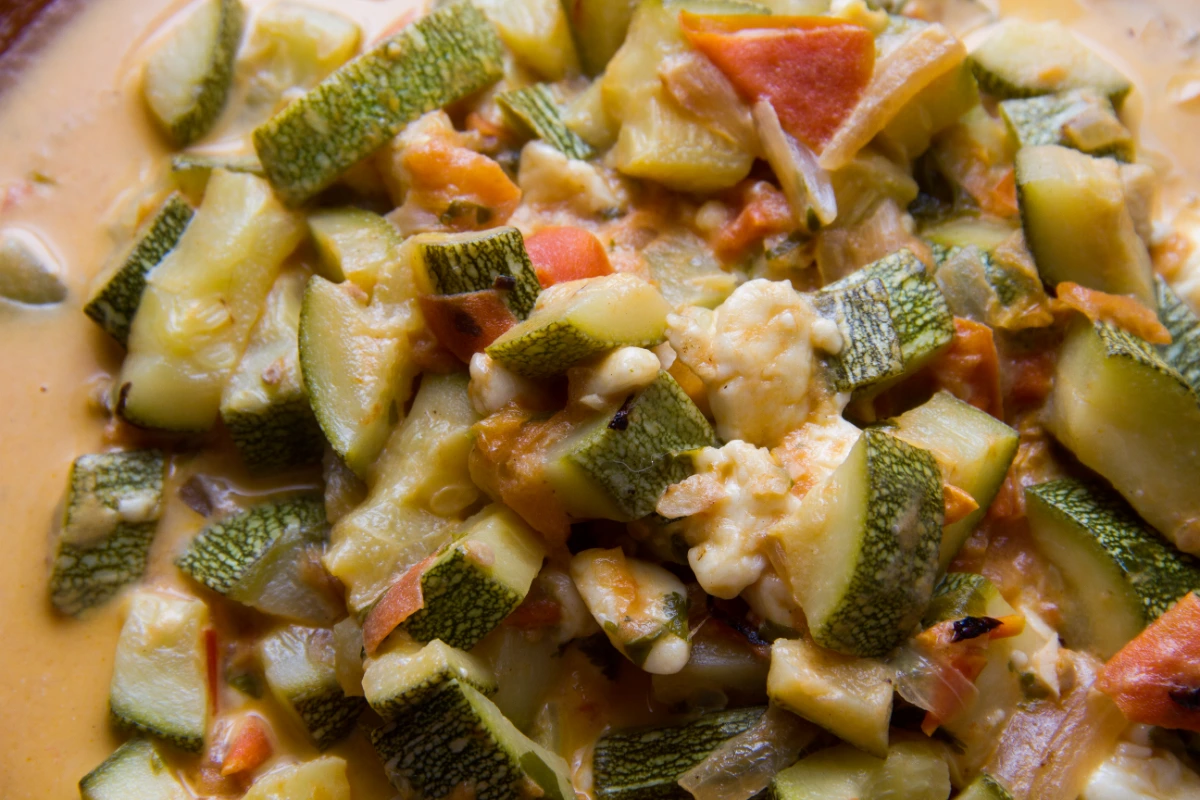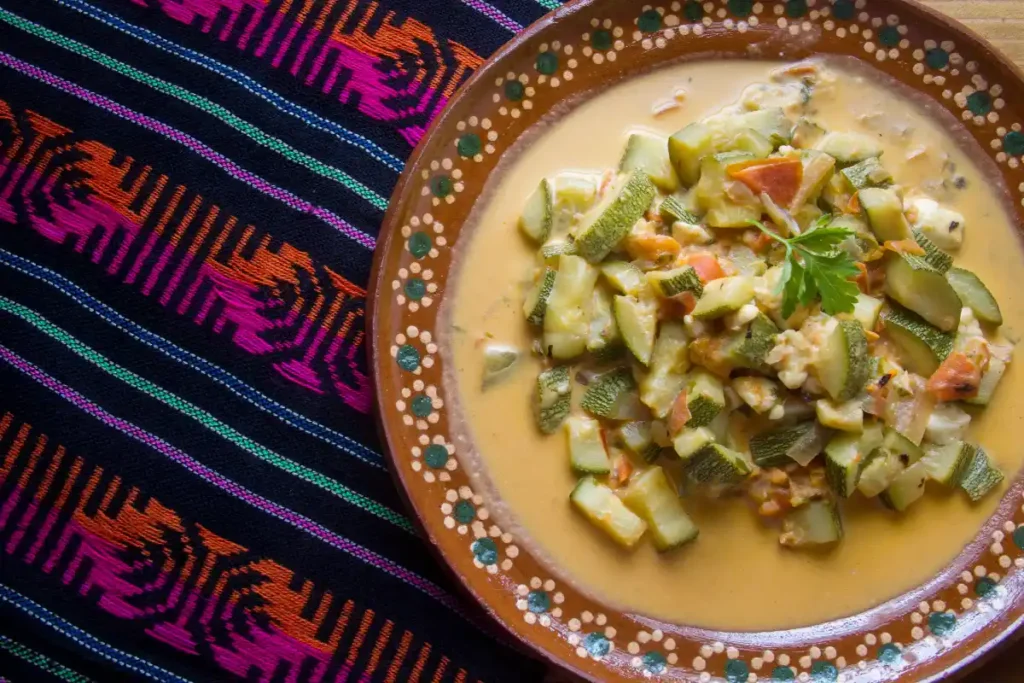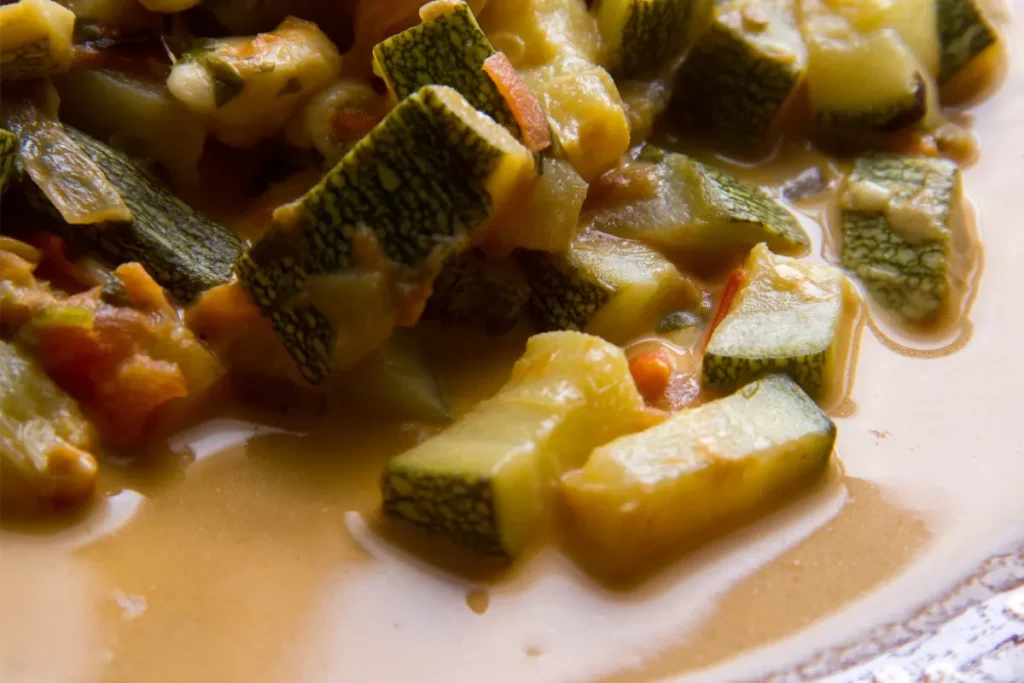Get ready to embark on a culinary adventure to Mexico, where vibrant flavors and fresh ingredients reign supreme. Our star of the show? Calabacitas, is a beloved dish that embodies the essence of Mexican home cooking. In this comprehensive guide, we’ll delve into everything you need to know about calabacitas, from its humble origins and irresistible taste to its versatility and health benefits. So, grab your apron, and let’s get cooking!
Introduction to Calabacitas
What is Calabacitas?
Calabacitas, meaning “little squash” in Spanish, is a traditional Mexican dish that celebrates the bounty of summer. At its core, calabacitas is a simple yet flavorful medley of zucchini or other summer squash, corn, onions, tomatoes, and green chiles. This humble dish holds a special place in Mexican cuisine, often gracing family tables and festive gatherings alike. Its origins can be traced back to the indigenous people of Mexico, who cultivated squash and corn for centuries. Over time, calabacitas evolved into the beloved dish we know today, reflecting the diverse culinary influences that shaped Mexican food culture.
Why is Calabacitas so Popular?
Well, the answer is simple: calabacitas is incredibly versatile, nutritious, and easy to prepare! This makes it a go-to option for busy weeknights or casual get-togethers. Its adaptability allows you to customize the recipe to your liking, adding cheese, meat, or even a creamy twist. Plus, calabacitas is packed with essential vitamins and minerals, making it a healthy and satisfying meal. And let’s not forget its budget-friendly nature – calabacitas utilizes readily available and affordable ingredients, ensuring everyone can enjoy this delicious dish.
Key Ingredients and Common Variations
Essential Ingredients
To whip up a classic calabacitas, you’ll need a handful of readily available ingredients:
- Zucchini or other summer squash: The star of the show, providing a tender and slightly sweet base.
- Corn: Adds a delightful sweetness and pop of color, whether fresh, frozen, or canned.
- Onion and garlic: Essential aromatics that build a flavor foundation.
- Tomatoes: Contribute a touch of acidity and freshness, either fresh or canned.
- Green chiles (optional): For those who enjoy a bit of a kick, green chiles like poblano or jalapeño add a pleasant heat.
Popular Variations
- Calabacitas with cheese: Crumble some queso fresco or cotija cheese on top for a salty and tangy finish.
- Calabacitas with meat: Incorporate cooked chicken, pork, or chorizo for a heartier meal.
- Creamy calabacitas: Stir in cream cheese or sour cream for a rich and indulgent twist.
- Vegan calabacitas: Omit the cheese and use vegetable broth for a plant-based delight.
No matter your preference, calabacitas offers endless possibilities to explore and savor. Stay tuned for the next part, where we’ll dive into the step-by-step process of creating this culinary masterpiece!
Cooking Calabacitas
How to Make Calabacitas
Ready to whip up a batch of delicious calabacitas? Let’s dive into a simple step-by-step guide that will have you savoring this Mexican favorite in no time. Remember, cooking is all about experimentation, so feel free to adjust the ingredients and quantities to your liking!
Ingredients:
- 2 tablespoons olive oil
- 1 medium onion, chopped
- 2 cloves garlic, minced
- 2 medium zucchini, diced
- 1 cup corn kernels (fresh, frozen, or canned)
- 1 (14.5 oz) can of diced tomatoes, undrained
- 1 green chile, such as poblano or jalapeño (optional), chopped
- Salt and pepper to taste
Instructions:
- Sauté the aromatics: Heat olive oil in a large skillet or pot over medium heat. Add chopped onion and cook until softened and translucent, about 5 minutes. Stir in minced garlic and cook for an additional minute until fragrant.
- Add the vegetables: Toss in the diced zucchini and corn kernels. Cook for about 5-7 minutes, stirring occasionally, until the zucchini is tender-crisp.
- Simmer with tomatoes: Pour in the diced tomatoes with their juices and the chopped green chile (if using). Season with salt and pepper to taste. Bring to a simmer and cook for another 10-15 minutes, allowing the flavors to meld together beautifully.
- Serve and enjoy: Once the calabacitas are heated through and the flavors have developed, remove from heat. Serve hot as a side dish or a light vegetarian main course.
Tips:
- Choosing the Freshest Ingredients: Opt for firm zucchini with smooth skin and vibrant color. Fresh corn cut straight from the cob offers the best flavor, but frozen or canned corn works well too.
- Variations and Substitutions: Feel free to explore different types of summer squash, such as yellow squash or pattypan squash. If you prefer a milder dish, omit the green chiles or remove the seeds for less heat. For a vegan version, use vegetable broth instead of oil for sautéing.
- Serving Ideas: Calabacitas pairs perfectly with a variety of dishes. Enjoy it alongside grilled chicken or fish, tucked into warm tortillas, or as a topping for rice and beans. To learn more about the nutritional benefits of zucchini and other vegetables, check out the USDA National Nutrient Database.
Tips and Tricks for Perfect Calabacitas
To ensure your calabacitas turns out perfectly every time, here are a few handy tips and tricks:
- Texture Matters: Avoid overcooking the zucchini; it should be tender-crisp, not mushy. Cooking times may vary depending on the size of your zucchini dice.
- Avoiding Watery Calabacitas: If your calabacitas seem watery, continue simmering uncovered to allow excess moisture to evaporate. You can also drain some of the liquid from the canned tomatoes before adding them to the skillet.
- Tools and Equipment: A large skillet or pot works best for cooking calabacitas. A sturdy spatula or wooden spoon will help you stir the vegetables without breaking them apart.
With these tips in mind, you’re well on your way to mastering the art of calabacitas. Get ready to impress your family and friends with this simple yet satisfying dish that captures the essence of Mexican cuisine!
Exploring Calabacitas
Calabacitas: Beyond the Basics
While the classic calabacitas recipe is undeniably delicious, don’t be afraid to venture beyond the basics and explore its culinary potential. This versatile dish serves as a blank canvas for your creativity, allowing you to experiment with different flavors, textures, and presentations.
- Calabacitas Tacos or Burritos: Elevate your taco Tuesday by filling warm tortillas with calabacitas and your favorite toppings. Think shredded cheese, salsa, avocado crema, or a dollop of Greek yogurt. For a heartier option, wrap everything up in a large flour tortilla for a satisfying burrito.
- Calabacitas Casserole or Gratin: Transform calabacitas into a comforting casserole or gratin. Layer it with cheese, breadcrumbs, and herbs in a baking dish, then bake until golden and bubbly. This is a perfect way to use up leftover calabacitas and create a satisfying main course.
- Calabacitas Soup or Stew: On a chilly day, nothing beats a warm and comforting soup or stew. Purely cooked calabacitas with vegetable broth for a smooth and creamy soup. Or, add beans, lentils, or other vegetables to create a hearty stew that will warm you from the inside out.
Calabacitas transcends borders and culinary traditions, making appearances in various cuisines with its unique twist. For example, in the southwestern United States, calabacitas often incorporate ingredients like black beans, corn, and cilantro, reflecting the region’s culinary heritage.
Health Benefits of Calabacitas
Beyond its incredible taste and versatility, calabacitas boasts an impressive nutritional profile, making it a healthy and nourishing choice for the whole family.
- Rich in Vitamins and Minerals: Calabacitas is packed with essential vitamins and minerals, including vitamin C, vitamin A, potassium, and folate. These nutrients play vital roles in supporting immune function, vision, heart health, and cell growth.
- Low in Calories and Fat: For those watching their calorie intake, calabacitas is a guilt-free indulgence. It’s naturally low in calories and fat, making it a perfect addition to a balanced diet.
- Good Source of Fiber: The fiber content in calabacitas promotes healthy digestion and helps you feel full and satisfied after a meal. This can be particularly beneficial for weight management and blood sugar control.
So, the next time you’re looking for a delicious and nutritious meal, look no further than calabacitas. This Mexican gem offers a symphony of flavors, endless possibilities, and a wealth of health benefits.
FAQs about Calabacitas
As with any popular dish, questions about calabacitas abound. Let’s address some of the most frequently asked questions to ensure you have all the information you need to create this culinary masterpiece with confidence.
Is Calabaza the same as zucchini?
Not exactly. While “calabaza” translates to “squash” in English and often refers to zucchini in some regions, it can also encompass other types of squash, such as West Indian pumpkin or Cuban squash, depending on the context and location.
What is calabaza in English green?
“Calabaza verde” in English translates to “green squash.” This could refer to various green squash varieties, including zucchini, chayote, or other regional green squash types.
Can you eat calabacita raw?
Yes, calabacita, especially if it refers to zucchini, can be eaten raw. Young and tender zucchini are often enjoyed raw in salads or as a crudité with dips. However, larger or more mature squash may have tougher skin and seeds, making them better suited for cooked preparations.
What can I substitute for corn?
If you don’t have corn on hand, you can use other vegetables like green beans, peas, or chopped bell peppers. These alternatives will add their unique flavors and textures to the calabacitas.
How can I make calabacitas spicier?
To amp up the heat, add more chopped green chiles, such as jalapeño or serrano. You can also incorporate a pinch of cayenne pepper or red pepper flakes for an extra kick.
Can I freeze calabacitas?
Yes, calabacitas freezes well. Allow it to cool completely before transferring it to an airtight container or freezer bag. Frozen calabacitas can be stored for up to 3 months. To reheat, thaw it in the refrigerator overnight and then warm it up on the stovetop or in the microwave.
What are some good side dishes to serve with calabacitas?
Calabacitas complements a wide range of dishes. It pairs beautifully with grilled chicken, fish, or steak. It also makes a delightful side dish for tacos, enchiladas, or burritos. For a vegetarian feast, serve calabacitas alongside rice and beans or a simple salad.
With these FAQs answered you’re now equipped to tackle any calabacitas-related challenge that comes your way. Get ready to impress your taste buds and explore the endless possibilities of this beloved Mexican dish!
Calabacitas Around the World
A Global Culinary Journey with Calabacitas
While calabacitas holds a special place in Mexican cuisine, its versatility and adaptability have allowed it to transcend borders and find its way onto tables around the world. Let’s take a culinary journey and explore how different cultures have embraced and reinterpreted this beloved dish.
- Southwestern United States: In the southwestern United States, calabacitas often incorporate ingredients like black beans, corn, and cilantro, reflecting the region’s culinary heritage and the influence of Mexican cuisine. This variation is a testament to the fusion of flavors and cultural exchange that has shaped American cuisine.
- Mediterranean Influences: The combination of zucchini, tomatoes, and herbs found in calabacitas resonates with Mediterranean flavors. Some variations incorporate ingredients like olives, feta cheese, and oregano, creating a delightful fusion of Mexican and Mediterranean tastes.
- Asian Inspirations: With a little creativity, calabacitas can take on Asian-inspired flavors. Adding soy sauce, ginger, garlic, and a touch of sesame oil creates a stir-fry reminiscent of Asian cuisine. This adaptation showcases the versatility of calabacitas and its ability to harmonize with diverse culinary traditions.
The global presence of calabacitas is a testament to its universal appeal. Its simple yet flavorful combination of ingredients resonates with people from various cultures, making it a dish that transcends borders and unites food lovers worldwide.
Calabacitas: A Dish for All Seasons
While calabacitas is often associated with summer’s bounty of fresh zucchini and corn, it can be enjoyed year-round with a few simple adaptations.
- Winter Variations: During the colder months, substitute zucchini with other seasonal vegetables like butternut squash, sweet potatoes, or Brussels sprouts. These hearty vegetables add warmth and depth of flavor to the dish, making it perfect for cozy winter meals.
- Frozen or Canned Vegetables: When fresh produce is scarce, frozen or canned vegetables can be used to create calabacitas at any time of year. Opt for high-quality frozen or canned vegetables to ensure optimal flavor and texture.
- Creative Additions: To add more substance and variety, incorporate protein sources like beans, lentils, tofu, or cooked meat into your calabacitas. These additions make it a complete and satisfying meal for any season.
The adaptability of calabacitas allows you to enjoy its deliciousness regardless of the season or availability of fresh produce. With a little creativity, you can create a warm and comforting dish that brings a taste of Mexico to your table all year long.
Conclusion: A Celebration of Flavor and Culture
Our journey through the world of calabacitas has revealed a dish that is much more than just a combination of ingredients. It is a celebration of flavor, culture, and culinary creativity. From its humble origins in Mexico to its global adaptations, calabacitas has captured the hearts and taste buds of people worldwide.
Whether you prefer the classic recipe or enjoy exploring its many variations, calabacitas offers a delicious and nutritious way to experience the vibrant flavors of Mexican cuisine. Its versatility, ease of preparation, and health benefits make it a dish that can be enjoyed by everyone, regardless of dietary preferences or culinary skills.
So, why not embark on your calabacitas adventure? Gather fresh ingredients, experiment with different flavors, and create a dish that reflects your unique taste and culinary inspiration. With each bite, you’ll savor the essence of Mexican culture and the joy of cooking a meal that nourishes both body and soul.
¡Buen provecho!
More Delicious Recipes:
- Mini Tacos: Dive into the world of Mini Tacos, where bold flavors come in bite-sized packages! Ideal for any gathering, these customizable tacos cater to all tastes.
- Deep Fried Ice Cream: Experience the unique pleasure of Deep Fried Ice Cream, where crispy meets creamy in an irresistible dessert. This eye-catching treat is surprisingly easy to make.




2 thoughts on “Calabacitas: A Delicious Mexican Dish Full of Flavor and Versatility”